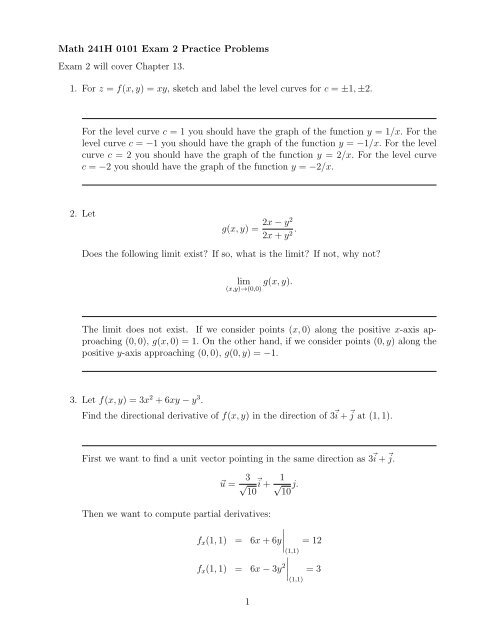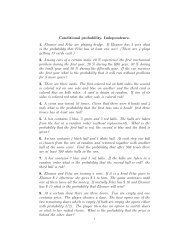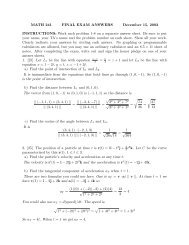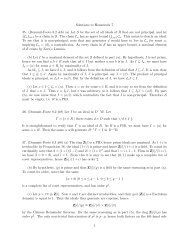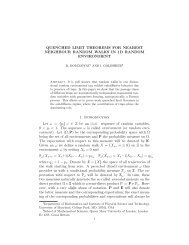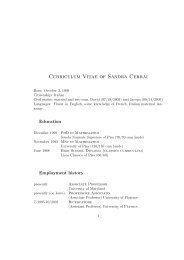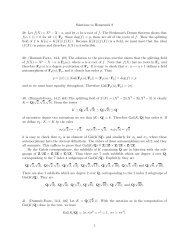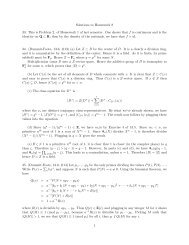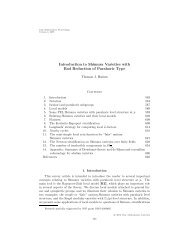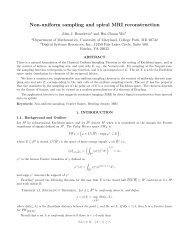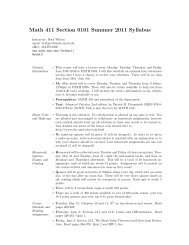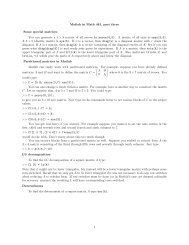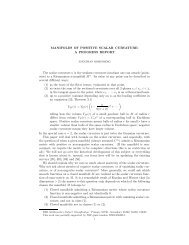Solutions to exam 2 practice problems
Solutions to exam 2 practice problems
Solutions to exam 2 practice problems
Create successful ePaper yourself
Turn your PDF publications into a flip-book with our unique Google optimized e-Paper software.
Math 241H 0101 Exam 2 Practice Problems<br />
Exam 2 will cover Chapter 13.<br />
1. For z = f(x, y) = xy, sketch and label the level curves for c = ±1, ±2.<br />
For the level curve c = 1 you should have the graph of the function y = 1/x. For the<br />
level curve c = −1 you should have the graph of the function y = −1/x. For the level<br />
curve c = 2 you should have the graph of the function y = 2/x. For the level curve<br />
c = −2 you should have the graph of the function y = −2/x.<br />
2. Let<br />
g(x, y) =<br />
2x − y2<br />
2x + y 2 .<br />
Does the following limit exist? If so, what is the limit? If not, why not?<br />
lim g(x, y).<br />
(x,y)→(0,0)<br />
The limit does not exist. If we consider points (x, 0) along the positive x-axis approaching<br />
(0, 0), g(x, 0) = 1. On the other hand, if we consider points (0, y) along the<br />
positive y-axis approaching (0, 0), g(0, y) = −1.<br />
3. Let f(x, y) = 3x 2 + 6xy − y 3 .<br />
Find the directional derivative of f(x, y) in the direction of 3⃗i + ⃗j at (1, 1).<br />
First we want <strong>to</strong> find a unit vec<strong>to</strong>r pointing in the same direction as 3⃗i + ⃗j.<br />
⃗u = 3 √<br />
10<br />
⃗i + 1 √<br />
10<br />
j.<br />
Then we want <strong>to</strong> compute partial derivatives:<br />
f x (1, 1) = 6x + 6y<br />
∣ = 12<br />
(1,1)<br />
∣<br />
∣∣∣(1,1)<br />
f x (1, 1) = 6x − 3y 2 = 3<br />
1
Then<br />
D ⃗u f(1, 1) = 36 √<br />
10<br />
+ 3 √<br />
10<br />
= 39 √<br />
10<br />
.<br />
4. A differentiable function f(x, y) has the property that f(1, 3) = 7 and ∇f(1, 3) =<br />
2⃗i − 5⃗j.<br />
(a) Find the equation of the tangent line <strong>to</strong> the level curve of f through the point<br />
(1, 3).<br />
To find the equation of the tangent line we need the slope of the tangent line and<br />
a point on the line. We know that (1, 3) is a point on the line. We know the<br />
vec<strong>to</strong>r 2⃗i − 5⃗j is perpendicular <strong>to</strong> the line. Then the vec<strong>to</strong>r 5⃗i + 2⃗j is tangent <strong>to</strong><br />
the line since the dot product of the two vec<strong>to</strong>rs is zero.<br />
So the equation for the tangent line is:<br />
y = 2 (x − 1) + 3.<br />
5<br />
(b) Find the equation of the tangent plane <strong>to</strong> the surface z = f(x, y) at the point<br />
(1, 3, 7).<br />
Let g(x, y, z) = f(x, y) − z. Then the surface z = f(x, y) is the level surface of<br />
g(x, y, z) when c = 0. Then, ∇g = f x<br />
⃗i + f y<br />
⃗j − ⃗ k is a vec<strong>to</strong>r perpendicular <strong>to</strong> the<br />
tangent plane. So the equation of the plane is:<br />
2(x − 1) − 5(y − 3) − (z − 7) = 0.<br />
5. Let F (u, v) be a function of two variables. Find f ′ (x) if f(x) = F (x, x).<br />
Using the chain rule we get<br />
f ′ (x) = ∂F ∂u<br />
∂u ∂x + ∂F ∂v<br />
∂v ∂x<br />
= F u (x, x) + F v (x, x)<br />
2
6. Let f(x, y) = sin(xy).<br />
(a) What is the direction in which f increases most rapidly at the point (1, π).<br />
∇f(1, π) = f x (1, π)⃗i + f y (1, π)⃗j<br />
= y cos(xy)<br />
∣<br />
⃗i + x cos(xy)<br />
∣<br />
⃗j<br />
(1,π) (1,π)<br />
= −π⃗i − ⃗j<br />
(b) What is the maximal directional derivative at the point (1, π).<br />
||∇f(1, π)|| = √ π 2 + 1<br />
7. Let f(x, y) = sin(x + 2y). Estimate f(π/2 + 0.01, π/4 − 0.01).<br />
First compute partial derivatives:<br />
f x (π/2, π/4) = cos(x + 2y)<br />
∣ = cos(π) = −1<br />
(π/2,π/4) f y (π/2, π/4) = 2 cos(x + 2y)<br />
∣ = 2 cos(π) = −2<br />
(π/2,π/4)<br />
The change in f is approximately<br />
∆f ≈ f x (π/2, π/4)∆x + f y (π/2, π/4)∆y<br />
= −1(0.01) − 2(−0.01) = 0.01<br />
Since f(π/2, π/4) = 0, f(π/2 + 0.01, π/4 − 0.01) ≈ 0.01.<br />
3
8. Let f(x, y) = x 3 + y 3 − 6y 2 − 3x + 9. Find and classify the critical points as local<br />
minima, local maxima, saddle points or neither.<br />
First compute the gradient vec<strong>to</strong>r:<br />
∇f = (3x 2 − 3)⃗i + (3y 2 − 12y)⃗j.<br />
The gradient always exists so the critical points are only when the gradient is zero.<br />
This happens when x = ±1 and y = 0, 4. So we have four critical points <strong>to</strong> <strong>exam</strong>ine:<br />
(−1, 0), (−1, 4), (1, 0) and (1, 4).<br />
Compute the second derivatives:<br />
f xx = 6x<br />
f xy = 0<br />
f yy = 6y − 12<br />
Then, the discriminant is:<br />
D = f xx f yy − f 2 xy.<br />
For each critical point compute the discriminant:<br />
D(−1, 0) = (−6)(−12) − 0 = 72 > 0<br />
D(−1, 4) = (−6)(12) − 0 = −72 < 0<br />
D(1, 0) = 6(−12) − 0 = −72 < 0<br />
D(1, 4) = 6(12) − 0 = 72 > 0<br />
So by the second derivative test, (−1, 0) is a local maximum, (−1, 4) and (1, 0) are<br />
saddle points and (1, 4) is a local minimum.<br />
9. Find the maximum and minimum values of f(x, y) = x 2 + 3y 2 on the quarter circle<br />
x 2 + y 2 ≤ 4 with x, y ≥ 0.<br />
First solve for the critical points:<br />
So we have a critical point at (0, 0).<br />
f x = 2x<br />
f y = 6y<br />
Since f(0, 0) = 0 and for all other points (x, y) on the region f(x, y) ≥ 0, 0 is a global<br />
minimum value of f.<br />
We know that there exists a global maximum and minimum since the region is closed<br />
and bounded. Since there are no other critical points, the global maximum must occur<br />
4
on the boundary. The boundary has three pieces. The first piece is when x = 0 and<br />
0 ≤ y ≤ 2; along this piece, f achieve its maximum value when y = 2, f(0, 2) = 12.<br />
The second piece is when y = 0 and 0 ≤ x ≤ 2; along this piece, f achieves its<br />
maximum value when x = 2, f(2, 0) = 4.<br />
The last piece is the circular arc, where x 2 + y 2 = 4. Then along this piece, f(x, y) =<br />
4 + 2y 2 . This will achieve its maximum when y is as big as possible, i.e. when y = 2<br />
but then x = 0. So f(0, 2) = 12 is the value of the global maximum.<br />
10. A closed rectangular box has volume 27cm 3 . What are the lengths of the edges giving<br />
the minimum surface area? Don’t forget <strong>to</strong> justify why it is a global minimum.<br />
Let l, w, h be the length, width and height of the box. Since the volume of the box is<br />
27, l = 27/(wh).<br />
The <strong>to</strong>tal surface area is 2wh + 2lh + 2lw. Substituting the relation above we get a<br />
function of two variables:<br />
First solve for the critical points:<br />
f(w, h) = 2wh + 54<br />
w + 54<br />
h .<br />
f w = 2h − 54<br />
w 2 = 0<br />
h = 27<br />
w 2<br />
f h = 2w − 54 = 0<br />
h 2<br />
54<br />
2w −<br />
= 0<br />
(27/w 2 ) 2<br />
w − w4<br />
27<br />
= 0<br />
w(1 − w3<br />
27 ) = 0<br />
w = 0, w = 3<br />
Since w must be nonzero, w = 3 and h = 3 is the only critical point.<br />
To check that it is a local minimum, use the second derivative test:<br />
f ww = 108<br />
w 3<br />
f hw = 2<br />
f hh = 108<br />
h 3<br />
5
Then evaluate the discriminant at the point (3, 3),<br />
D = ( 108<br />
27 )2 − 4 = 16 − 4 = 12 > 0<br />
Since D > 0 and f ww > 0, the critical point is a local minimum.<br />
The possible values of w, h are w, h > 0. Notice that f(3, 3) = 54.<br />
To check that it is a global minimum, check that in each of the following situations<br />
f(w, h) > 54.<br />
(a) w ≤ 1/4<br />
(b) h ≤ 1/4<br />
(c) w ≥ 1/4, h ≥ 400<br />
(d) h ≥ 1/4, w ≥ 400<br />
Since the region R where 1/4 ≤ w ≤ 400 and 1/4 ≤ h ≤ 400 is closed and bounded f<br />
achieves a global minimum on R. Since there is only one critical point and the value<br />
at that critical point is less than the values of f along the entire boundary the critical<br />
point is a global minimum.<br />
11. Let f(x, y) = x 2 + 6y 2 and let g(x, y) = x + 3y.<br />
(a) Use Lagrange multipliers <strong>to</strong> find the minimum of f(x, y) subject <strong>to</strong> the constraint<br />
g(x, y) = 10. Assume that there is a global minimum.<br />
(b) Explain why f(x, y) has no maximum subject <strong>to</strong> the constraint g(x, y) = 10.<br />
(c) Explain why g(x, y) has a maximum and a minimum subject <strong>to</strong> the constraint<br />
f(x, y) = 9.<br />
(d) Find the maximum and minimum of g(x, y) subject <strong>to</strong> the constraint f(x, y) = 9.<br />
(a) Notice I added ”Assume that there is a global minimum” <strong>to</strong> the question. If we assume<br />
this, then we know it must occur at a point where either the gradients of f and g are<br />
parallel, an endpoint of the constraint or when the gradient of g is zero.<br />
First compute the gradients of f and g :<br />
∇f(x, y) = 2x⃗i + 12y⃗j<br />
∇g(x, y)<br />
= ⃗i + 3⃗j<br />
6
Since the gradient of g is never zero, and g = 10 has no endpoints, set the gradients<br />
parallel <strong>to</strong> each other<br />
∇f(x, y) = λ∇g(x, y)<br />
This becomes<br />
2x = λ 12y = 3λ<br />
2x = λ 4y = λ<br />
So, 2x = 4y or x = 2y. Plug this in<strong>to</strong> our constraint equation x + 3y = 10 and get<br />
y = 2. So x = 4.<br />
So the minimum is (4, 2).<br />
(b) f(x, y) has no maximum because we can make x as large as we want and still satisfy<br />
the constraint. This will make f(x, y) arbitrarily large.<br />
(c) g(x, y) has a max and min subject <strong>to</strong> the constraint f(x, y) = 9 because that constraint<br />
is described by a closed curve. By the extreme value theorem, g achieves a max and<br />
min over that curve.<br />
(d) First compute the gradients of f and g :<br />
∇f(x, y) = 2x⃗i + 12y⃗j<br />
∇g(x, y)<br />
= ⃗i + 3⃗j<br />
Since the gradient of f is zero only at the origin (which does not lie in our constraint),<br />
and the constraint has no endpoints, set the gradients parallel <strong>to</strong> each other<br />
λ∇f(x, y) = ∇g(x, y)<br />
This becomes<br />
λ2x = 1 12yλ = 3<br />
2x = 1/λ 4y = 1/λ<br />
So, 2x = 4y or x = 2y. Plug this in<strong>to</strong> our constraint equation (2y) 2 + 6y 2 = 9.<br />
This gives y = ±3 √<br />
10<br />
. This yields the following two points: ( 6 √<br />
10<br />
,<br />
3 √<br />
10<br />
) and ( −6 √<br />
10<br />
, −3 √<br />
10<br />
).<br />
Since g( 6 √<br />
10<br />
,<br />
3 √<br />
10<br />
) = 15 √<br />
10<br />
and g( −6 √<br />
10<br />
, −3 √<br />
10<br />
) = −15 √<br />
10<br />
the first point is where the global max<br />
occurs and the second point is where the global min occurs.<br />
7


